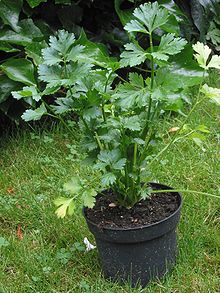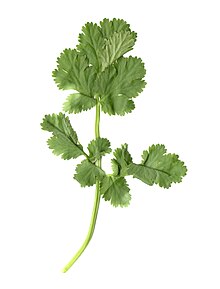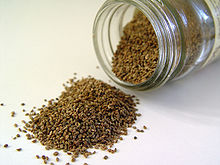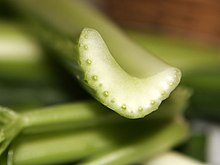Celery: Difference between revisions
m Delink dates (WP:MOSUNLINKDATES) using AWB |
DeadLinkBOT (talk | contribs) Bot updating dead link(s) - See the pages I've made this fix on; Know a link that need updated? Leave me a message. |
||
| Line 21: | Line 21: | ||
Celery was described by [[Carolus Linnaeus]] in Volume One of his ''[[Species Plantarum]]'' in 1753.<ref>{{la icon}} {{cite book | last=Linnaeus | first=C | authorlink=Carolus Linnaeus | title=Species Plantarum: Tomus I | publisher=Holmiae. (Laurentii Salvii). | date=1753}}</ref> |
Celery was described by [[Carolus Linnaeus]] in Volume One of his ''[[Species Plantarum]]'' in 1753.<ref>{{la icon}} {{cite book | last=Linnaeus | first=C | authorlink=Carolus Linnaeus | title=Species Plantarum: Tomus I | publisher=Holmiae. (Laurentii Salvii). | date=1753}}</ref> |
||
The closely related ''[[Apium bermejoi]]'' from the island of [[Minorca]] is one of the rarest plants in Europe, with fewer than 100 individuals left.<ref> |
The closely related ''[[Apium bermejoi]]'' from the island of [[Minorca]] is one of the rarest plants in Europe, with fewer than 100 individuals left.<ref>{{IUCNlink|61608|IUCN Redlist: ''Apium bermejo}}.</ref> |
||
==Uses== |
==Uses== |
||
Revision as of 20:51, 21 November 2009
| Celery | |
|---|---|

| |

| |
| Scientific classification | |
| Kingdom: | |
| (unranked): | |
| (unranked): | |
| (unranked): | |
| Order: | |
| Family: | |
| Genus: | |
| Species: | A. graveolens
|
| Binomial name | |
| Apium graveolens | |
| Nutritional value per 100 g (3.5 oz) | |
|---|---|
| Energy | 57 kJ (14 kcal) |
3 g | |
| Sugars | 2 g |
| Dietary fibre | 1.6 g |
0.2 g | |
0.7 g | |
| Vitamins | Quantity %DV† |
| Vitamin C | 3% 3 mg |
| Other constituents | Quantity |
| Water | 95 g |
| †Percentages estimated using US recommendations for adults,[1] except for potassium, which is estimated based on expert recommendation from the National Academies.[2] | |
Apium graveolens is a plant species in the family Apiaceae commonly known as celery (var. dulce) or celeriac (var. rapaceum) depending on whether the petioles (stalks) or roots are eaten.
Taxonomy
Celery was described by Carolus Linnaeus in Volume One of his Species Plantarum in 1753.[3]
The closely related Apium bermejoi from the island of Minorca is one of the rarest plants in Europe, with fewer than 100 individuals left.[4]
Uses
Apium graveolens is used around the world as a vegetable, either for the crisp petiole (leaf stalk) or the fleshy taproot.
In temperate countries, celery is also grown for its seeds. Actually very small fruit, these "seeds" yield a valuable volatile oil used in the perfume and pharmaceutical industries. They also contain an organic compound called apiol. Celery seeds can be used as flavouring or spice, either as whole seeds or ground and mixed with salt, as celery salt. Celery salt can also be made from an extract of the roots. Celery salt is used as a seasoning, in cocktails (notably to enhance the flavour of Bloody Mary cocktails), on the Chicago-style hot dog, and in Old Bay Seasoning.
Celery, onions, and bell peppers are the holy trinity of Louisiana Creole and Cajun cuisine. Celery, onions, and carrots make up the French mirepoix, often used as a base for sauces and soups. Celery is a staple in many soups, such as chicken noodle soup. Celery is an important ingredient in Indian cuisines including in Indian Curry[citation needed].
Celery is widely eaten by guinea pigs, dogs, horses, birds, squirrels,and small rodents.
Medicine


The use of celery seed in pills for relieving pain was described by Aulus Cornelius Celsus ca. 30 AD.[5] Celery seeds contain a compound called 3-N-butyl-phthalide that has been demonstrated to lower blood pressure in rats.
Nutrition
Celery is valuable in weight-loss diets, where it provides low-calorie dietary fiber bulk. Celery contains androstenone.[6] Bergapten in the seeds can increase photosensitivity, so the use of essential oil externally in bright sunshine should be avoided. The oil and large doses of seeds should be avoided during pregnancy: they can act as a uterine stimulant. Seeds intended for cultivation are not suitable for eating as they are often treated with fungicides. There is a common belief that celery is so difficult for humans to digest, that it has negative calories because human digestion burns more calories than can be extracted.[7] Celery seeds are also a great source of calcium, and are regarded as a good alternative to animal products.[8]
Allergies
Celery is amongst a small group of foods (headed by peanuts) that appear to provoke the most severe allergic reactions; for people with celery allergy, exposure can cause potentially fatal anaphylactic shock.[9] The allergen does not appear to be destroyed at cooking temperatures. Celery root—commonly eaten as celeriac, or put into drinks—is known to contain more allergen than the stalk. Seeds contain the highest levels of allergen content. Exercise-induced anaphylaxis may be exacerbated. An allergic reaction also may be triggered by eating foods that have been processed with machines that have previously processed celery, making avoiding such foods difficult. In contrast with peanut allergy being most prevalent in the US, celery allergy is most prevalent in Central Europe.[10] In the European Union, foods that contain or may contain celery, even in trace amounts, have to be clearly marked as such.
History
Daniel Zohary and Maria Hopf[11] note that celery leaves and inflorescences were part of the garlands found in the tomb of pharaoh Tutankhamun (died 1323 BC), and celery mericarps dated to the 7th century BC were recovered in the Heraion of Samos. However, they note "since A. graveolens grows wild in these areas it is hard to decide whether these remains represent wild or cultivated forms." Only by classical times is it certain that celery was cultivated.
M. Fragiska mentions an archeological find of celery dating to the 9th century BC, at Kastanas; however, the literary evidence for ancient Greece is far more abundant. In Homer's Iliad, the horses of the Myrmidons graze on wild celery that grows in the marshes of Troy, and in Odyssey there is mention of the meadows of violet and wild celery surrounding the cave of Calypso.[12]
Cultural depictions
A chthonian symbol among the ancient Greeks, celery was said to have sprouted from the blood of Kadmilos, father of the Cabeiri, chthonian divinities celebrated in Samothrace, Lemnos and Thebes. The spicy odour and dark leaf colour encouraged this association with the cult of death. In classical Greece celery leaves were used as garlands for the dead, and the wreaths of the winners at the Isthmian Games were first made of celery before being replaced by crowns made of pine. According to Pliny the Elder[13] in Achaea the garland worn by the winners of the sacred Nemean Games was also made of celery.[12]
The name celery retraces the plant's route of successive adoption in European cooking, as the English celery (1664) is derived from the French céleri coming from the Lombard term, seleri, from the Latin selinon, borrowed from Greek.[14] Celery's Mediterranean origins are still commemorated in the French expression céleri d'Italie.
Celery's surprisingly late arrival in the English kitchen is an end-product of the long tradition of seed selection needed to reduce the sap's bitterness and increase its sugars. By 1699 John Evelyn could recommend it in his Acetaria. A Discourse of Sallets: "Sellery, apium Italicum, (and of the Petroseline Family) was formerly a stranger with us (nor very long since in Italy) is an hot and more generous sort of Macedonian Persley or Smallage...and for its high and grateful Taste is ever plac'd in the middle of the Grand Sallet, at our Great Mens tables, and Praetors feasts, as the Grace of the whole Board".
Cultivation
Apium graveolens grows to 1 m tall. The leaves are pinnate to bipinnate leaves with rhombic leaflets 3–6 cm long and 2–4 cm broad. The flowers are creamy-white, 2–3 mm diameter, produced in dense compound umbels. The seeds are broad ovoid to globose, 1.5–2 mm long and wide.
In North America, commercial production of celery is dominated by the varieties called Pascal celery.[15] Gardeners can grow a range of cultivars, many of which differ little from the wild species, mainly in having stouter leaf stems. They are ranged under two classes, white and red; the white cultivars being generally the best flavoured, and the most crisp and tender.
The wild form of celery is known as smallage. It has a furrowed stalk with wedge-shaped leaves, the whole plant having a coarse, earthy taste, and a distinctive smell. The stalks are not usually eaten (except in soups or stews in French cuisine), but the leaves may be used in salads, and its seeds are those sold as a spice.[16] With cultivation and blanching, the stalks lose their acidic qualities and assume the mild, sweetish, aromatic taste particular to celery as a salad plant.
The plants are raised from seed, sown either in a hot bed or in the open garden according to the season of the year, and after one or two thinnings out and transplantings they are, on attaining a height of 15–20 cm, planted out in deep trenches for convenience of blanching, which is affected by earthing up to exclude light from the stems.
In the past, celery was grown as a vegetable for winter and early spring; it was perceived as a cleansing tonic, welcomed to counter the salt-sickness of a winter diet. By the 19th century the season for celery had been extended, to last from the beginning of September to late in April.[17]
Harvesting and storage
Harvesting occurs when the average size of celery in a field is marketable; due to extremely uniform crop growth, fields are harvested only once. Petioles and leaves are removed and harvested celery are packed by size and quality (determined by color, shape, straightness and thickness of petiole, stalk and midrib length and absence of disease, cracks, splits, insect damage and rot). Under optimal conditions, celery can be stored for up to seven weeks between 0 to 2 °C (32 to 36 °F). Inner stalks may continue growing if kept at temperatures above 0 °C (32 °F). Freshly-cut petioles of celery are prone to decay, which can be prevented or reduced through the use of sharp blades during processing, gentle handling, and proper sanitation.[18] When wrapped in aluminum foil, the stalk will stay fresh for several weeks.[citation needed]
See also
References
- ^ United States Food and Drug Administration (2024). "Daily Value on the Nutrition and Supplement Facts Labels". FDA. Archived from the original on 2024-03-27. Retrieved 2024-03-28.
- ^ National Academies of Sciences, Engineering, and Medicine; Health and Medicine Division; Food and Nutrition Board; Committee to Review the Dietary Reference Intakes for Sodium and Potassium (2019). Oria, Maria; Harrison, Meghan; Stallings, Virginia A. (eds.). Dietary Reference Intakes for Sodium and Potassium. The National Academies Collection: Reports funded by National Institutes of Health. Washington, DC: National Academies Press (US). ISBN 978-0-309-48834-1. PMID 30844154. Archived from the original on 2024-05-09. Retrieved 2024-06-21.
- ^ Template:La icon Linnaeus, C (1753). Species Plantarum: Tomus I. Holmiae. (Laurentii Salvii).
- ^ IUCN Redlist: Apium bermejo.
- ^ Celsus, de Medicina, Thayer translation
- ^ Teng CM, Lee LG, Ko SN, et al., (1985) "Inhibition of platelet aggregation by apigenin from Apium graveolens". Asia Pacific Journal of Pharmacology 3:85
- ^ snopes.com: Celery and Negative Calories
- ^ Calcium sources
- ^ Celestin J, Heiner DC. West J, "Allergy and Immunology: Food-Induced Anaphylaxis". Western Journal of Medicine 158.6 (June 1993): 610-611.
- ^ Bublin M, Radauer C, Wilson IBH, Kraft D, Scheiner O, Breiteneder H and Hoffmann-Sommergruber K Cross-reactive N-glycans of Api g 5, a high molecular weight glycoprotein allergen from celery, are required for immunoglobulin E binding and activation of effector cells from allergic patients The FASEB Journal. 2003;17:1697-1699.
- ^ D. Zohary and M. Hopf, Domestication of Plants in the Old World, (3rd ed. 2000) p.202.
- ^ a b Fragiska, M. (2005). "Wild and Cultivated Vegetables, Herbs and Spices in Greek Antiquity". Environmental Archaeology 10 (1): 73-82.
- ^ Pliny, Natural History XIX.46.
- ^ OED, s.v. "Celery".
- ^ R.L. de Vilmorin (1950) Pascal celery and its origin Journal of the New York Botanical Garden 51 pp 39-41.
- ^ "Smallage". Practically Edible: The World's Biggest Food Encyclopedia. Retrieved 2009-05-03.
- ^ William Robinson and W. P. Thomson, The Vegetable Garden (3rd ed., 1920), p. 227.
- ^ Cantwell, M (2002-06-10). "Celery: Recommendations for Maintaining Postharvest Quality". Post-harvest technology research and information center. Retrieved 2008-03-04.
{{cite web}}: Unknown parameter|coauthors=ignored (|author=suggested) (help)
External links
- Barbagallo, Tricia (June 1, 2005). "Black Beach: The Mucklands of Canastota, New York" (PDF). Retrieved 2008-06-04.
- on Apium graveolens
- Quality standards (in PDF format), from the USDA website
